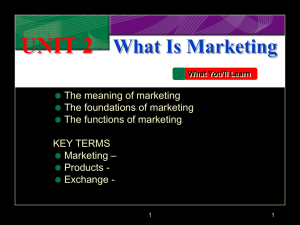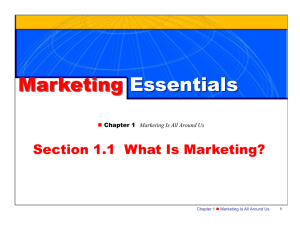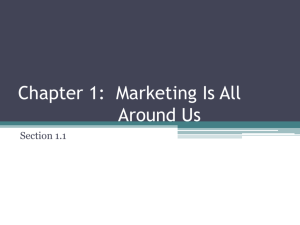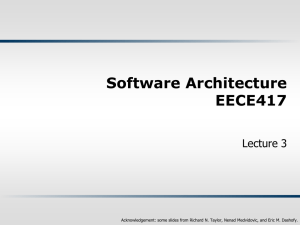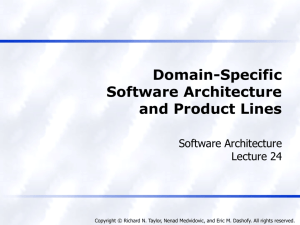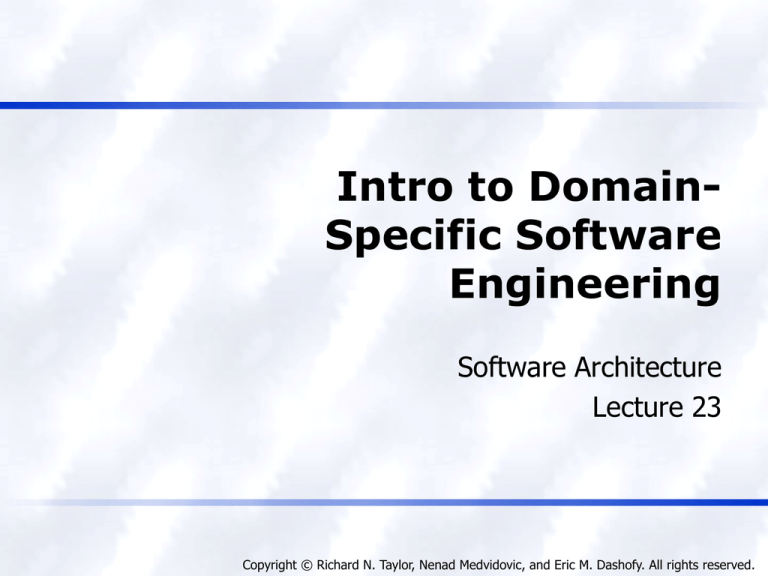
Intro to DomainSpecific Software
Engineering
Software Architecture
Lecture 23
Copyright © Richard N. Taylor, Nenad Medvidovic, and Eric M. Dashofy. All rights reserved.
Software Architecture
Foundations, Theory, and Practice
Objectives
Concepts
What is domain-specific software engineering
(DSSE)
The “Three Lampposts” of DSSE: Domain,
Business, and Technology
Domain Specific Software Architectures
Product Lines
Relationship between DSSAs, Product Lines, and
Architectural Styles
Examples of DSSE at work
2
Software Architecture
Foundations, Theory, and Practice
Objectives
Concepts
What is domain-specific software engineering
(DSSE)
The Three Key Factors of DSSE: Domain,
Business, and Technology
Domain Specific Software Architectures
Product Lines
Relationship between DSSAs, Product Lines, and
Architectural Styles
Examples of DSSE at work
3
Software Architecture
Foundations, Theory, and Practice
Domain-Specific Software
Engineering
The traditional view of software engineering shows us
how to come up with solutions for problems de novo
But starting from scratch every time is infeasible
This will involve re-inventing many wheels
Once we have built a number of systems that do similar
things, we gain critical knowledge that lets us exploit
common solutions to common problems
In theory, we can simply build “the difference”
between our new target system and systems that
have come before
4
Software Architecture
Foundations, Theory, and Practice
Examples of Domains
Compilers for programming languages
Consumer electronics
Electronic commerce system/Web stores
Video game
Business applications
Basic/Standard/“Pro”
We can subdivide, too:
Avionics systems
Boeing Jets
Boeing
747-400
5
Software Architecture: Foundations, Theory, and Practice; Richard N. Taylor, Nenad Medvidovic, and Eric M. Dashofy; (C) 2008 John Wiley & Sons, Inc. Reprinted with permission.
Software Architecture
Foundations, Theory, and Practice
Traditional Software Engineering
One particular problem can be solved in innumerable
ways
6
Software Architecture: Foundations, Theory, and Practice; Richard N. Taylor, Nenad Medvidovic, and Eric M. Dashofy; (C) 2008 John Wiley & Sons, Inc. Reprinted with permission.
Software Architecture
Foundations, Theory, and Practice
Architecture-Based Software
Engineering
Given a single problem, we select from a handful of
potential architectural styles or architectures, and go
from these into specific implementations
7
Software Architecture: Foundations, Theory, and Practice; Richard N. Taylor, Nenad Medvidovic, and Eric M. Dashofy; (C) 2008 John Wiley & Sons, Inc. Reprinted with permission.
Software Architecture
Foundations, Theory, and Practice
Domain-Specific Software
Engineering
We map regions of the problem space (domains) into domainspecific software architectures (DSSAs)
These are specialized into application-specific architectures
These are implemented
8
Software Architecture: Foundations, Theory, and Practice; Richard N. Taylor, Nenad Medvidovic, and Eric M. Dashofy; (C) 2008 John Wiley & Sons, Inc. Reprinted with permission.
Software Architecture
Foundations, Theory, and Practice
Three Key Factors of DSSE
Domain
Must have a domain to constrain the problem space and
focus development
Technology
Must have a variety of technological solutions—tools,
patterns, architectures & styles, legacy systems—to
bring to bear on a domain
Business
Business goals motivate the use of DSSE
Minimizing costs: reuse assets when possible
Maximize market: develop many related applications
for different kinds of end users
9
Software Architecture
Foundations, Theory, and Practice
Three Key Factors
Domain
Must have a domain
to constrain the
problem space
Domain
and focus
development
Business
Technology
10
Software Architecture
Foundations, Theory, and Practice
Three Key Factors
Technology
Must have a variety
of technological
solutions—tools,
Domain
patterns,
architectures &
styles, legacy
systems—to bring
to bear on a
domain
Business
Technology
11
Software Architecture
Foundations, Theory, and Practice
Three Key Factors
Business
Business goals
motivate the use of
DSSE
Domain
Minimizing
costs: reuse
assets
when possible
Maximize
market: develop
many related
applications for
different kinds
of end users
Business
Technology
12
Software Architecture
Foundations, Theory, and Practice
Three Key Factors
Domain + Business
“Corporate Core
Competencies”
Domain expertise
augmented by
business
acumen and
knowledge of
the market
Domain
Business
Technology
13
Software Architecture
Foundations, Theory, and Practice
Three Key Factors
Domain + Technology
“Application Family
Architectures”
Domain
All possible
technological
solutions to
problems in a
domain
Uninformed
and unconstrained by
business goals
and knowledge
Business
Technology
14
Software Architecture
Foundations, Theory, and Practice
Three Key Factors
Business + Technology
“Domain independent
infrastructure”
Domain
Tools and
techniques for
constructing
systems
independent of any
particular domain
E.g., most generic ADLs,
UML, compilers, word
processors, generalpurpose PCs
Business
Technology
15
Software Architecture
Foundations, Theory, and Practice
Three Key Factors
Domain + Business +
Technology
“Domain-specific
software engineering” Domain
Applies technology
to domain-specific
goals, tempered by
business and market
knowledge
Business
Technology
16
Software Architecture
Foundations, Theory, and Practice
Three Key Factors
Product-Line Architectures
A specific, related set
of solutions within
a broader DSSE
Domain
More focus on
commonalities and
variability between
individual solutions
Business
Technology
17
Software Architecture
Foundations, Theory, and Practice
Becoming More Concrete
Applying DSSE means developing a set of artifacts more
specific than an ordinary software architecture
Focus on aspects of the domain
Focus on domain-specific solutions, techniques, and
patterns
These are
A domain model and
A domain-specific software architecture (DSSA)
18
Software Architecture
Foundations, Theory, and Practice
Domain Model
A domain model is a set of artifacts that capture
information about a domain
Functions performed
Objects (also known as entities) that perform the
functions, and on which the functions are performed
Data and information that flows through the system
Standardizes terminology and semantics
Provides the basis for standardizing (or at least
normalizing) descriptions of problems to be solved in the
domain
19
Software Architecture
Foundations, Theory, and Practice
Domain Model
20
Software Architecture: Foundations, Theory, and Practice; Richard N. Taylor, Nenad Medvidovic, and Eric M. Dashofy; (C) 2008 John Wiley & Sons, Inc. Reprinted with permission.
Software Architecture
Foundations, Theory, and Practice
Domain Model
Defines vocabulary for the domain
21
Software Architecture: Foundations, Theory, and Practice; Richard N. Taylor, Nenad Medvidovic, and Eric M. Dashofy; (C) 2008 John Wiley & Sons, Inc. Reprinted with permission.
Software Architecture
Foundations, Theory, and Practice
Domain Model
Describes the entities and data in the domain
22
Software Architecture: Foundations, Theory, and Practice; Richard N. Taylor, Nenad Medvidovic, and Eric M. Dashofy; (C) 2008 John Wiley & Sons, Inc. Reprinted with permission.
Software Architecture
Foundations, Theory, and Practice
Domain Model
Defines how entities and data combine to provide features
23
Software Architecture: Foundations, Theory, and Practice; Richard N. Taylor, Nenad Medvidovic, and Eric M. Dashofy; (C) 2008 John Wiley & Sons, Inc. Reprinted with permission.
Software Architecture
Foundations, Theory, and Practice
Domain Model
Defines how data and control flow through entities
24
Software Architecture: Foundations, Theory, and Practice; Richard N. Taylor, Nenad Medvidovic, and Eric M. Dashofy; (C) 2008 John Wiley & Sons, Inc. Reprinted with permission.
Software Architecture
Foundations, Theory, and Practice
(Partial) Domain Dictionary
Lunar Module (LM): this is the portion of the spacecraft that lands on the moon.
It consists of two main parts: the Ascent Stage (which holds the crew cabin) and the
Descent Stage, which contains thrusters used for controlling the landing of the LM.
Reaction Control System (RCS): a system on the Lunar Module responsible for the
stabilization during lunar surface ascent/descent and control of the spacecraft’s orientation
(attitude) and motion (translation) during maneuvers
Vertical velocity (see also One-dimensional motion):
For a free-falling object with no air resistance, ignoring the rotation of the lunar surface,
the altitude is calculated as follows:
y = ½ * a * t2 + vi * t + yi
y = altitude
a = constant acceleration due to gravity on a lunar body (see Acceleration for sample values)
t = time in seconds; vi = initial velocity; yi = initial altitude
When thrust is applied, the following equation is used:
y = ½ * (aburner – agravity) * t2 + vi * t + yi
y = altitude
aburner = constant acceleration upward due to thrust
agravity = constant acceleration due to gravity on a lunar
(see Acceleration for sample values)
t = time in seconds; vi = initial velocity; yi = initial altitude
25
Software Architecture: Foundations, Theory, and Practice; Richard N. Taylor, Nenad Medvidovic, and Eric M. Dashofy; (C) 2008 John Wiley & Sons, Inc. Reprinted with permission.
Software Architecture
Foundations, Theory, and Practice
Info Model: Context Info Diagram
Defines highlevel entities
Defines what is
considered
inside and
outside the
domain (or
subdomains)
Defines
relationships and
high-level flows
26
Software Architecture: Foundations, Theory, and Practice; Richard N. Taylor, Nenad Medvidovic, and Eric M. Dashofy; (C) 2008 John Wiley & Sons, Inc. Reprinted with permission.
Software Architecture
Foundations, Theory, and Practice
Info Model: Entity-Relationship
Diagram
Defines entities
and cardinal
relationships
between them
27
Software Architecture: Foundations, Theory, and Practice; Richard N. Taylor, Nenad Medvidovic, and Eric M. Dashofy; (C) 2008 John Wiley & Sons, Inc. Reprinted with permission.
Software Architecture
Foundations, Theory, and Practice
Info Model: Object Diagram
Defines attributes
and operations on
entities
Closely resembles
class diagram in
UML but may be
more abstract
28
Software Architecture: Foundations, Theory, and Practice; Richard N. Taylor, Nenad Medvidovic, and Eric M. Dashofy; (C) 2008 John Wiley & Sons, Inc. Reprinted with permission.
Software Architecture
Foundations, Theory, and Practice
Feature Model: Feature
Relationship Diagram
Feature Relationship Diagram – Landing Phase
Mandatory: The Lunar Lander must continually read altitude from the Landing Radar and
relay that data to Houston with less than 500 msec of latency. Astronauts must be able to
control the descent of the Lunar Lander using manual control on the descent engine.
The descent engine must respond to control commands in 250msec, with or without
a functioning DSKY…
Optional/Variant: Lunar Lander provides the option to land automatically or allow the
crew to manually steer the spacecraft.
Quality Requirements:
Real-time requirements: The thrusters and the descent engine must be able to respond to
commands from the computer system in real-time.
Fault tolerance: Lunar Lander must be able to continue in its flight-path even when the
main computer system (Primary Navigation Guidance & Control) goes down. Lunar Lander
must be able to maintain system altitude even when one of the thrusters and propellant
supplies goes down in the Reaction Control System.
Describes overall mission operations of a system
Describes major features and decomposition
29
Software Architecture: Foundations, Theory, and Practice; Richard N. Taylor, Nenad Medvidovic, and Eric M. Dashofy; (C) 2008 John Wiley & Sons, Inc. Reprinted with permission.
Software Architecture
Foundations, Theory, and Practice
Feature Model: Use Case Diagram
Defines use cases
within the domain
Similar to use case
models in UML
30
Software Architecture: Foundations, Theory, and Practice; Richard N. Taylor, Nenad Medvidovic, and Eric M. Dashofy; (C) 2008 John Wiley & Sons, Inc. Reprinted with permission.
Software Architecture
Foundations, Theory, and Practice
Feature Model: Representation
Diagram
Defines how
information is
presented to
human users
31
Software Architecture: Foundations, Theory, and Practice; Richard N. Taylor, Nenad Medvidovic, and Eric M. Dashofy; (C) 2008 John Wiley & Sons, Inc. Reprinted with permission.
Software Architecture
Foundations, Theory, and Practice
Operational Model: Data Flow
Diagram
Focuses on
data flow between
entities with no
notion of control
32
Software Architecture: Foundations, Theory, and Practice; Richard N. Taylor, Nenad Medvidovic, and Eric M. Dashofy; (C) 2008 John Wiley & Sons, Inc. Reprinted with permission.
Software Architecture
Foundations, Theory, and Practice
Operational
Model:
Control Flow
Diagram
Focuses on
control flow between
entities separate from
data flow
33
Software Architecture: Foundations, Theory, and Practice; Richard N. Taylor, Nenad Medvidovic, and Eric M. Dashofy; (C) 2008 John Wiley & Sons, Inc. Reprinted with permission.
Software Architecture
Foundations, Theory, and Practice
Operational Model: State
Transition Diagram
Focuses on states
of systems and
transitions between
them
Resembles UML
state diagrams
34
Software Architecture: Foundations, Theory, and Practice; Richard N. Taylor, Nenad Medvidovic, and Eric M. Dashofy; (C) 2008 John Wiley & Sons, Inc. Reprinted with permission.
Software Architecture
Foundations, Theory, and Practice
Reference Requirements
Mandatory
Must display the current status of the Lunar Lander (horizontal and
vertical velocities, altitude, remaining fuel)
Must indicate points earned by player based on quality of landing
Optional
May display time elapsed
Variant
May have different levels of difficulty based on pilot experience
(novice, expert, etc)
May have different types of input depending on whether
Auto Navigation is enabled
Auto Throttle is enabled
May have to land on different celestial bodies
Moon
Mars
Jupiter’s moons
Asteroid
35
Software Architecture: Foundations, Theory, and Practice; Richard N. Taylor, Nenad Medvidovic, and Eric M. Dashofy; (C) 2008 John Wiley & Sons, Inc. Reprinted with permission.
Software Architecture
Foundations, Theory, and Practice
Domain-Specific Software
Architecture
Definition: Definition. A domain-specific software
architecture (DSSA) comprises:
a reference architecture, which describes a general
computational framework for a significant domain of
applications;
a component library, which contains reusable chunks
of domain expertise; and
an application configuration method for selecting and
configuring components within the architecture to
meet particular application requirements.
(Hayes-Roth)
36
Software Architecture
Foundations, Theory, and Practice
Reference Architecture
Definition. Reference architecture is the set of principal
design decisions that are simultaneously applicable to
multiple related systems, typically within an application
domain, with explicitly defined points of variation.
Reference architectures are still architectures (since they
are also sets of principal design decisions)
Distinguished by the presence of explicit points of
variation (explicitly “unmade” decisions)
37
Software Architecture
Foundations, Theory, and Practice
Different Kinds of Reference
Architecture
Complete single product architecture
A fully worked out exemplar of a system in a
domain, with optional documentation as to how to
diversify
Can be relatively weak due to lack of explicit
guidance and possibility that example is a ‘toy’
Incomplete invariant architecture
Points of commonality as in ordinary architecture,
points of variation are indicated but omitted
Invariant architecture with explicit variation
Points of commonality as in ordinary architecture,
specific variations indicated and enumerated
38
Software Architecture
Foundations, Theory, and Practice
Example Reference Architecture
Structural view
of Lunar Lander
DSSA
Invariant with
explicit points
of variation
Satellite relay
Sensors
39
Software Architecture: Foundations, Theory, and Practice; Richard N. Taylor, Nenad Medvidovic, and Eric M. Dashofy; (C) 2008 John Wiley & Sons, Inc. Reprinted with permission.


